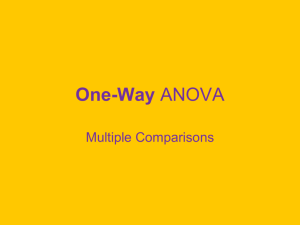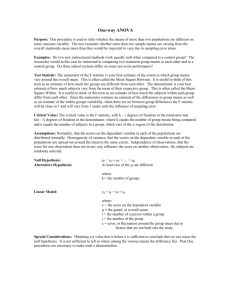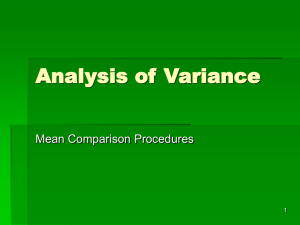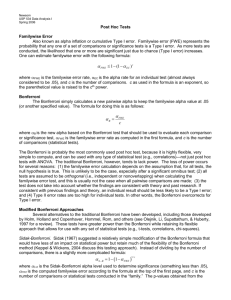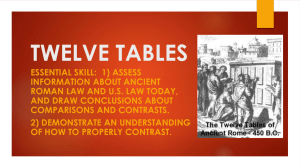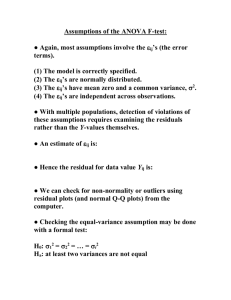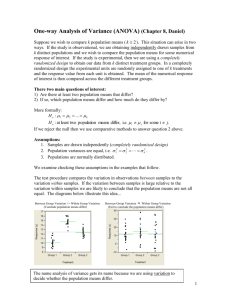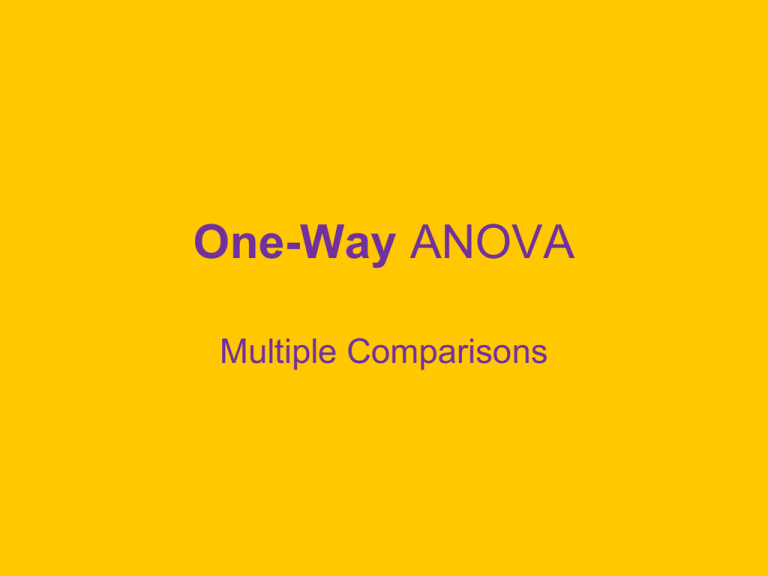
One-Way ANOVA
Multiple Comparisons
Pairwise Comparisons and Familywise Error
• fw is the alpha familywise, the
conditional probability of making one or
more Type I errors in a family of c
comparisons.
• pc is the alpha per comparison, the
criterion used on each individual
comparison.
• Bonferroni: fw cpc
Multiple t tests
• We could just compare each group mean
with each other group mean.
• For our 4-group ANOVA (Methods A, B, C,
and D) that gives c = 6 comparisons
• AB, AC, AD, BC, BD, and CD.
• Suppose that we decided to use the .01
criterion of significance for each
comparison.
c = 6, pc = .01
• alpha familywise might be as high as
6(.01) = .06.
• What can we do to lower familywise error?
Fisher’s Procedure
• Also called the “Protected Test” or
“Fisher’s LSD.”
• Do ANOVA first.
• If ANOVA not significant, stop.
• If ANOVA is significant, make pairwise
comparisons with t.
• For k = 3, this will hold familywise error at
the nominal level, but not with k > 3.
Computing t
• Assuming homogeneity of variance, use
the pooled error term from the ANOVA:
t
Mi M j
1
1
MSE
n
n
i
j
• For A versus D:
t (16) (8 2) .2 13.416, p .001
• For A versus C and B versus D:
t (16) 5 .2 11.180, p .001
• For B versus C
t (16) (7 3) .2 8.944, p .001
• For A vs B, and C vs D,
t (16) 1 .5(1/ 5 1/ 5) 2.236, p .04
Underlining Means Display
• arrange the means in ascending order
• any two means underlined by the same
line are not significantly different from one
another
Group A
B
C
D
Mean 2
3
7
8
Linear Contrasts
•
•
•
•
•
•
One coefficient for each group mean
Sum to zero
One set negative, one positive
Groups A B C D E
-3 -3 2 2 2 compares (AB) with (CDE)
0 0 -2 1 1 compares C with (DE)
Standard Contrast Coefficients
•
•
•
•
•
•
n = number of means in set
Coefficients -1/n1 and 1/n2
Sum = 0
Sum of absolute values = 2
-1/2 -1/2 1/3 1/3 1/3 codes (AB) vs. (CDE)
0 0 -1 1/2 1/2 codes C vs. (DE)
Linear Contrasts, 5 Means
• I want to contrast combined groups A and
B with combined groups C, D, and E.
• .5, .5, 1/3, 1/3, 1/3 are the contrast
coefficients
• contrast C with combined D and E
• 0, 0, 1, .5, .5.
• Sum of the coefficients must = 0
• One set is positive, the other negative
Calculate a Contrast & SS
ˆ ci Mi
SSˆ
ˆ
2
c 2j
n
j
Unequal Sample Sizes
nˆ 2
SSˆ
2
cj
Equal Sample Sizes
Methods AB vs. CD (Teach
ANOVA Data)
• The means are (2, 3) vs. (7, 8)
– ie, 2.5 vs. 7.5, a difference of 5.
• The coefficients are -.5, -.5, .5, .5
ˆ .5(2) .5(3) .5(7) .5(8) 5
2
5(5)
5(25)
MSˆ
125
.25 .25 .25 .25
1
F(1, 16) = 125/.5 = 250, p << .01
Standard Error & CI for Psi
sˆ MSE
c
MSE
sˆ
n
2
j
nj
Unequal Sample Sizes
Equal Sample Sizes
• For a CI, go out in each direction tcrit sˆ
•
.5
sˆ
5
.3162
95% CI is 5 2.12(.3162),
4.33 to 5.67.
Standardized Contrasts
• How different are the two sets of means in
standard deviation units?
ˆ s
• For our contrast,
dˆ 5
.5 7.07
Standardized Contrast from F
• SAS will give you the F for a contrast.
dˆ F
c 2j
nj
.25 .25 .25 .25
dˆ 250
7.07
5
Approximate CI for Contrast d
• Simply take the unstandardized CI and
divide each end by s.
• Our unstandardized CI was 4.33 to 5.67
• Divide each end by s = .707.
• Standardized CI is 6.12 to 8.02
Exact CI for Contrast d
• Conf_Interval-Contrast.sas
• The CI extends from 4.48 to 9.64
• Notice that this is considerably wider than
the approximate CI
2 for Contrast
• 2 = 125/138 = .9058
• partial 2 :
SSContrast
125
.93985
SSContrast SSError 125 8
• Notice that this excludes from the
denominator that part of the SSAmong that is
not captured by the contrast
CI for Contrast 2
• Conf-Interval-R2-Regr.sas
• For partial 2 enter the contrast F (1, 16) = 250. The CI is
[.85, .96].
• For 2 enter an adjusted F that adds to the denominator all
SS and df not captured by the contrast:
F
(SSTotal
SScontrast
SScontrast ) (dfTotal dfcontrast )
• F(1, 18) = 173.077; The CI is [.78, .94].
Orthogonal Contrasts
• Can obtain k-1 of these
• Each is independent of the others
a j bj
• It must be true that
• With equal sample sizes,
nj
0
a b
i
j
0
A
+.5
+1
B
+.5
1
C
1/3
0
D
1/3
0
E
1/3
0
0
0
0
0
1
0
.5
+1
.5
1
(.5)(1)+(.5)(-1)+(-1/3)(0)+(-1/3)(0)+(-1/3)(0) = 0
You verify that the cross products sum to zero for all other
pairs of rows.
If you calculated SScontrast for each of these four contrasts,
they would sum to be exactly equal to the SSAmong
Procedures Designed to Cap FW
• We have already discussed Fisher’s
Procedure, which does require that the
ANOVA be significant.
• None of the other procedures require that
the ANOVA be significant.
• They were designed to replace the
ANOVA, not be done after an ANOVA.
A Common Delusion
• Many mistakenly believe that all
procedures require a significant ANOVA.
• This is like being so paranoid about getting
an STD that you abstain from sex and
wear a condom.
• If you have done the one, you do not also
need to do the other.
Studentized Range Procedures
• These are often used when one wishes to
compare each group mean with each
other group mean.
• I prefer to make only comparisons that
address a research question.
• The test statistic is q.
• See the handout for an example using the
Student Newman Keuls procedure.
q, t, and F
q t 2
q 2F
• If you obtain t or F, by hand or by
computer, you can easily convert it into q
Tukey’s (a) Honestly Significant
Difference Test
• If part of the null is true and part false, the
SNK can allow to exceed its nominal
level.
• Tukey’s HSD is more conservative, and
does not allow to exceed its nominal
level.
Tukey’s (b) Wholly Significant
Difference Test
• SNK too liberal, HSD too conservative, OK
let us compromise.
• For the WSD the critical value of q is the
simple mean of what it would be for the
SNK and what it would be for the HSD.
Ryan-Einot-Gabriel-Welsch Test
• Holds familywise error at the stated level.
• Has more power than other techniques
which also adequately control familywise
error.
• SAS and SPSS will do it for you.
• It is much too difficult to do by hand.
Which Test Should I Use?
• If k = 3, use Fisher’s Procedure
• If k > 3, use REGWQ
• Remember, ANOVA does not have to be
significant to use REGWQ or any of the
procedures covered here other than
Fisher’s procedure.
The Bonferroni Procedure
• Compute an adjusted criterion of significance to
keep familywise error at desired level
pc
fw
c
• Although conservative, this procedure may be
useful when you are making a few focused
comparisons. Also known as the Dunn Test.
• For our data,
.01
pc
.00167
6
• Compare each p with the adjusted criterion.
• For these data, we get same results as with
Fisher’s procedure.
• In general, this procedure is very conservative
(robs us of power).
αFW with Orthogonal Contrasts
•
•
•
•
For each contrast, αpc = Pcond(Type I Error)
and (1- αpc) = Pcond(Not Type I Error)
With c independent contrasts,
(1- αpc)c = Pcond(No Type I Errors in c
comparisons)
• 1- (1- αpc)c = Familywise alpha
• For our example and three orthogonal
contrasts,
3
fw 1 1 .01 .0297
Dunn-Sidak Procedure
When the contrasts are NOT orthogonal,
fw 1 1 pc
c
• Accordingly, we can adjust the alpha this
way: Reject the null only if
p 1 1 fw
1/ c
• Slightly less conservative than the
Bonferroni.
Scheffé Test
• Assumes you make every possible
contrast, not just each mean with each
other.
• Very conservative.
• adjusted critical F equals (the critical value
for the treatment effect from the omnibus
ANOVA) times (the treatment degrees of
freedom from the omnibus ANOVA).
Dunnett’s Test
• Used only when you are comparing each
treatment group with a single control
group.
• Compute t as with the Bonferroni or LSD
test.
• Then use a special table of critical values.
Presenting the Results
• Teaching method significantly affected test scores, F(3,
16) = 86.66, MSE = 0.50, p < .001, η2 = .94, 95% CI
[.82, .94]. Pairwise comparisons were made with
Tukey’s HSD procedure, holding familywise error at a
maximum of .01. As shown in Table 1, the computer
intensive and discussion centered methods were
associated with significantly better student performance
than that shown by students taught with the actuarial and
book only methods. All other comparisons fell short of
statistical significance.
Table 1
Mean Quiz Performance By Students Taught With Different Methods
Method of Instruction
Actuarial
Book Only
Computer Intensive
Mean
2.00A
3.00A
7.00B
Discussion Centered
8.00B
Note. Means sharing a letter in their superscript
are not significantly different at the .01 level
according to a Tukey HSD test.
Familywise Error and the Boogey Man
• Please read my rant at
http://core.ecu.edu/psyc/wuenschk/docs30
/FamilywiseAlpha.htm
• These procedures may cause more harm
that good.
• They greatly sacrifice power, making Type
II errors much more likely.

